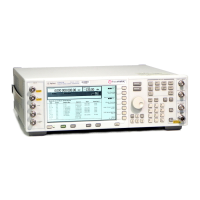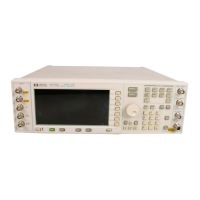Chapter 7 245
Digital Signal Interface Module
Operating the N5102A Module in Input Mode
2. Select the logic type required for the device being tested.
A caution message is displayed whenever a change is made to the logic types, and a softkey selection
appears asking for confirmation.
3. Refer to Figure 7-16. Press the
Port Config softkey.
In this menu, select either a serial, parallel, or parallel interleaved data transmission.
NOTE Within the data and clock setup softkey menus, some softkeys function relative to the
current configuration. Softkeys that are grayed out are not available for the current setup.
Refer to the help text to determine which parameter is causing the softkey to be unavailable.
Press the Help hardkey on the ESG front panel and then the softkey that is unavailable.
4. Select the port configuration for the device being tested.
Configuring the Clock Signal
1. Refer to Figure 7-17. Press the Clock Setup softkey.
Figure 7-17 Clock Setup Menu Location
From this softkey menu, set all of the clock parameters that synchronize the data between the N5102A
module and the device. From this menu, the clock signal phase can be changed so the clock occurs
during the valid portion of the data. Figure 7-18 shows the clock setup menu.
If the device or external clock does not match the frequency, one of the following error messages will
appear on the ESG:
803
Digital module input FIFO overflow error; There are more samples being produced than can be
consumed at the current clock rate. Verify that the digital module clock is set up properly.
Accesses the Clock Setup Menu

